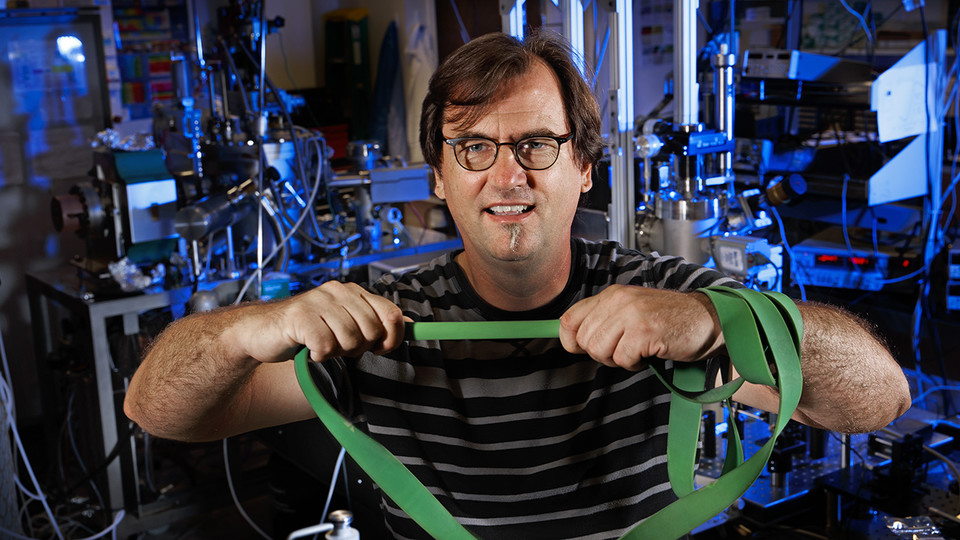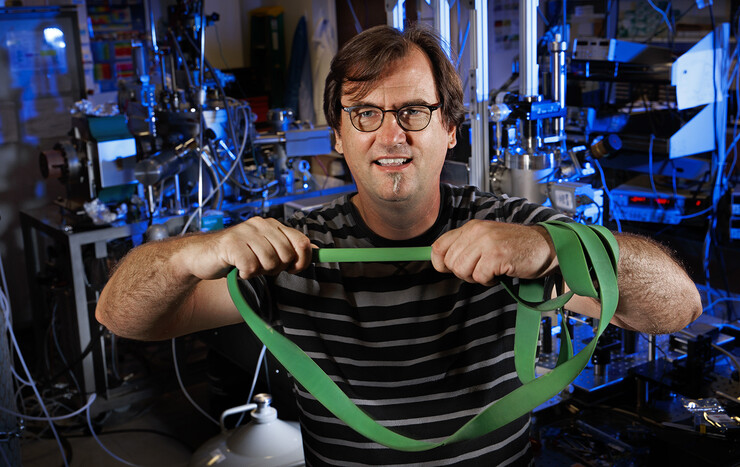· 4 min read
Husker physicist points way to controlling elasticity with magnetism

If Plastic Man, Elastigirl or Mr. Fantastic ever encounter Magneto, they’d better hope the iconic X-Men figure hasn’t read the latest research from Christian Binek.
The University of Nebraska-Lincoln physicist has found that, under certain conditions, the magnetic properties of a material can predict the relationship between its elasticity and temperature.
His finding may point the way toward controlling the elasticity of certain materials by designing their magnetic properties or applying a magnetic field to them. Given the ease with which magnetic fields can now be manipulated, Binek said, that could eventually mean tailoring elasticity with the mere press of a button or turn of a knob.
In the meantime, knowing that magnetism alone can predict how elasticity will respond – or not respond – to changes in temperature might help engineers better select or design materials for specific purposes.
Binek cited the 1986 disintegration of the Challenger space shuttle as a prominent example of elasticity’s importance in engineering design. The hardening and failure of an elastic O-ring on Challenger’s rocket booster – a consequence of cold temperatures – ultimately caused the shuttle to break apart, killing its seven crew members.
“So you can find materials that do not change elastic properties with temperature,” said Binek, professor of physics and astronomy. “You may find materials that change with temperature at will. And you may find materials where you can, at a given temperature, change the elastic properties by an external control.”
Thermodynamic duo
The laws of thermodynamics describe the relationships among many factors – temperature, entropy, volume, pressure – that affect how heat gets converted into other forms of energy. And it’s long been known that these laws encompass the properties of magnetism and elasticity.
But by deriving a new formula from existing ones, Binek managed to show that the elasticity-temperature relationship is basically encoded in the magnetism of a material.
Binek’s formula does have limitations. For now, it applies only if a material’s magnetic behavior changes linearly with the magnetic field being applied to it. Likewise, the material’s elasticity has to be linear, meaning that the amount of strain it exhibits has to be constantly proportional to the amount of physical stress being exerted on it.
Even so, the formula applies to materials featuring various forms of magnetism. That includes the form technically found in every material: diamagnetism, which describes a tendency to repel magnetic fields so weakly that it goes unnoticed without specialized instruments.
Superconductive materials – those that feature no resistance to electricity – display a pronounced form of diamagnetism below a critical temperature, at which point they begin completely repelling magnetic fields. Below that temperature threshold, Binek found something remarkable: The elasticity of superconductors no longer responds to temperature changes. That phenomenon held when he performed calculations for both ceramic and single-crystal superconductors, which have substantially different microscopic surfaces and atomic structures.
“My (mathematical) expression makes no claims about the material,” Binek said. “It’s very general. It only says: If the susceptibility (to magnetism) is constant, then the elastic property should be constant. If that is so, nothing else (about the superconductor) should matter, which is honestly a little difficult to believe.
“You wonder: How can something like an elastic property, which surely depends on structural details, be independent of anything related to the structure? But then you go to the (scientific) literature, apply your formula, and you find that, yes, it is correct.”
The elastic-magnetic formula also applies to materials for which magnetic fields induce a weak attraction known as paramagnetism. And ferromagnetic materials – those strongly attracted to magnetic fields and usually synonymous with the term “magnetic” – obey Binek’s formula above a certain temperature threshold that makes them behave more like their paramagnetic cousins.
Binek said the formula might even work for ferroelectric materials, whose alignment of positive and negative charges, or polarization, can be reversed by an electric field. Ferroelectricity facilitates the storage of electrical energy, making it useful in devices ranging from capacitors to random-access memory.
“Rather than tuning the elastic properties by a magnetic field, you may be able to tune them by electric fields,” he said. “Technologically, that could be even more interesting.
“There are certainly many applications that one could think of, and I think many of them can be useful. I hope this is not the end of the story, but rather the beginning.”
Binek conducted his research as part of the Nebraska Materials Research Science and Engineering Center, one of 21 MRSEC centers funded by the National Science Foundation.








